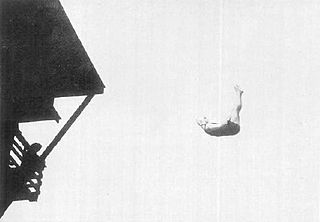
The 1912 Summer Olympics, officially known as the Games of the V Olympiad and commonly known as Stockholm 1912, were an international multi-sport event held in Stockholm, Sweden, between 6 July and 22 July 1912. The opening ceremony was held on 6 July.

At the 1908 Summer Olympics in London, two diving events were contested, both for men only. The competition was held on Tuesday 14 and Friday 24 July 1908. While the competitive events were restricted to men only, an exhibition was performed by two women on 18 July.

Diving was first introduced in the official programme of the Summer Olympic Games at the 1904 Games of St. Louis and has been an Olympic sport since. It was known as "fancy diving" for the acrobatic stunts performed by divers during the dive. This discipline of Aquatics, along with swimming, synchronised swimming and water polo, is regulated and supervised by the International Swimming Federation (FINA), the international federation (IF) for aquatic sports.

At the 1932 Summer Olympics in Los Angeles, four diving events were organized, two for men, and two for women. The competitions were held from Monday, 8 August 1932 to Saturday, 13 August 1932.

Finland competed at the 1912 Summer Olympics in Stockholm, Sweden. The Grand Duchy of Finland was an autonomous part of the Russian Empire at the time, which allowed Finland to compete separately of Russia Russia at the 1908 Summer Olympics due to Finland's special status. During the opening ceremony, Finland's team paraded under the national insignia flag of a Swedish-speaking female gymnastics club in Helsinki. 164 competitors, 162 men and 2 women, took part in 49 events in 10 sports.

Germany competed at the 1912 Summer Olympics in Stockholm, Sweden. 185 competitors, 180 men and 5 women, took part in 69 events in 14 sports. Due to the political fallout from World War I, this was the country's last appearance until 1928.

At the 1920 Summer Olympics in Antwerp, five diving events were contested. The women's 3 metre springboard competition was added to the Olympic programme. The competitions were held from Monday, 22 August 1920 to Monday, 29 August 1920.

At the 1924 Summer Olympics in Paris, five diving events were contested. The competitions were held from Monday, 14 July 1924 to Sunday, 20 July 1924.

At the 1928 Summer Olympics in Amsterdam, four diving events were contested. The men's plain high diving event was dropped from the Olympic program. The competitions were held from Monday, 6 August 1928 to Saturday, 11 August 1928.

At the 1936 Summer Olympics in Berlin, four diving events were contested, two for men, and two for women. The competitions were held from Monday 10 August 1936 to Saturday 15 August 1936.
The men's 3 metre springboard, also known as the spring-board diving competition, was one of four diving events on the diving at the 1912 Summer Olympics programme. The competition was held on Monday 8 July 1912, and Tuesday 9 July 1912. Eighteen divers from seven nations competed.

The men's plain high diving was one of four diving events on the diving at the 1912 Summer Olympics programme. The competition was held on Saturday 6 July 1912, on Sunday 7 July 1912, and on Thursday 11 July 1912. Thirty-one divers from nine nations competed.

The men's 10 metre platform, also known as plain and variety diving combined competition, was one of four diving events on the Diving at the 1912 Summer Olympics programme. The competition was held from Friday 12 July 1912 to Monday 15 July 1912. Twenty-three divers from seven nations competed.
The women's 10 metre platform, also known as high (plain) diving for ladies competition, was one of four diving events on the diving at the 1912 Summer Olympics programme. It was the first diving event for women at the Summer Olympic Games. The competition was held from Wednesday 10 July 1912, to Saturday 13 July 1912. Fourteen divers from three nations competed.
Axel Wilhelm Runström was a Swedish water polo player and diver who competed in the 1908 Summer Olympics and in the 1912 Summer Olympics.

Albert Zürner was a German diver who competed in the 1906 Summer Olympics, in the 1908 Summer Olympics, and in the 1912 Summer Olympics.

Carl Hjalmar August Johansson was a Swedish pioneer diver and swimmer who competed at the 1908 and 1912 Summer Olympics.

Carl Johan Erik "John" Jansson was a Swedish diver, who competed at the 1912, 1920 and 1924 Summer Olympics.

Isabelle Mary White was the first British diver to win a medal at the Olympic Games, and the first to win a European championship. She competed in four Olympics, including the 1912 Summer Olympics, where she won a bronze medal in the women's plain high diving event, as well as the 1920 Summer Olympics, 1924 Summer Olympics, and 1928 Summer Olympics. She also won a gold medal at the European Aquatics Championships in 1927.

Ernst Magnus Brandsten was a Swedish diver who competed in the 1912 Summer Olympics for Sweden in Springboard, Platform, and High diving. He was the swimming, water polo, and diving coach for Stanford University from 1916-1947.












